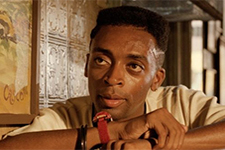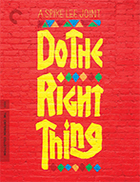Do the Right Thing
|  The decade of the 1980s closed with a series of blockbuster, franchise action movies—Batman, Indiana Jones and the Last Crusade, and Lethal Weapon 2—that topped the box office charts in the summer of 1989 and epitomized how the major Hollywood studios had treated screen violence throughout the decade: as one of many components in a high-concept package explicitly designed to attract as many of the most sought-after demographic as possible while simultaneously avoiding controversy and public outcry. Each of these three films is a slick, polished, well-crafted action vehicle with big stars, big budgets, and at best minimal attention paid to the real-life consequences of their many violent actions. Batman’s hyperbolic, film-noir-on-steroids vision of a world infested with crime is not terribly far removed from Indiana Jones’s cartoonish Nazi villains and Lethal Weapon 2’s nefarious South African diplomat-criminals. Each film is bulging with violent action and death, yet by 1989 such content was expected, if not routine, in Hollywood productions. Yet, 1989, the same year that gave us such largely trouble-free, audience-pleasing violence also produced a handful of studio-produced films that suggested a return to a more troubling and thought-provoking use of violence on the big screen, the kind that had been the hallmark of the late 1960s and throughout the 1970s. If one had to mark a specific moment when it seemed that the tide might turn, it would have to be the premiere of Spike Lee’s incendiary film-polemic Do the Right Thing at the Cannes Film Festival. Lee had made one independently financed film (1986’s She’s Gotta Have It) and one studio film for Columbia that was unceremoniously dumped in theaters (1988’s School Daze), so it was something of a gamble that Universal Studios, which had a pair of top-10 box office hits in 1989 with Back to the Future Part II and Parenthood, was willing to finance and distribute Do the Right Thing, even on its modest budget. It was a film that had great potential for generating the kind of controversy the studios had mostly avoided since the first few years of the 1980s; in fact, one could argue that Lee designed the film specifically to evoke controversy, which is exactly what it did. Set over the course of a single, blistering hot summer day in Brooklyn’s Bedford-Stuyvesant neighborhood, the film follows the interactions of a dozen or so characters as a means of dramatizing the myriad complexities of racial tensions. The drama centers largely around Sal’s Famous Pizzeria, a corner restaurant that has been run by the same Italian-American family for 25 years. The identity of the owner, Sal (Danny Aiello), is deeply embedded in his restaurant, which he sees as an extension of himself and his legacy. He runs it with his two adult sons, Pino (John Turturro) and Vito (Richard Edson), the former of whom is deeply resentful about running the restaurant in a largely African-American neighborhood. Pino’s racism is obvious and troubling, but what making Do the Right Thing such a powerful film is the way Lee dramatizes how racial resentment and anger cuts all through the neighborhood and across all colors and ethnicities. At one point, he literally stops the film cold and allows a different character to express his seething anger toward another group by speaking directly to the camera a caustic stream of racial insults. It’s a showy device (Lee has never been one to play by the rules, narratively or stylistically), but it clarifies in such direct, shocking fashion how no group is free of racism and resentment. We see that bitterness play out across the film in characters like Buggin Out (Giancarlo Esposito), a young black man who takes umbrage at the presence of Sal and his family restaurant in a predominantly black neighborhood, particularly because Sal only features famous Italian-Americans on the wall. There are tensions between the black residents and the Korean family who owns a corner grocery store, tensions between young Hispanic men playing Tejano music on their boom box and Radio Raheem (Bill Nunn), a towering African American who walks the neighborhood blasting Public Enemy’s anthemic “Fight the Power” on his. Three middle-age black men (Paul Benjamin, Frankie Faison, Robin Harris) who while the day away sitting under an umbrella talking and arguing embody frustration and capitulation to their lot in life, which is powerfully dramatized by the slow-motion shot of two white cops cruising through the neighborhood, eyeing them with the kind of suspicion that is predicated entirely by skin color. Other characters include Da Mayor (Ossie Davis), an aging alcoholic who nevertheless embodies a fundamental sense of decency (it is he who utters the film’s title as the ultimate means by which one should live one’s life); Mother Sister (Ruby Dee), an older woman who resents Da Mayor’s drunkenness; and Mister Señor Love Daddy (Samuel L. Jackson), the local DJ who tries to build community through his upbeat radio broadcasts. Caught in the middle is Mookie, played by Lee himself, who works as a delivery man for Sal, but understands the frustrations felt by Buggin Out and Radio Raheem, the latter of whom is banned from Sal’s for playing his music—which, as the restaurant is to Sal, is an extension of his identity—too loud. Mookie has his feet in multiple worlds, and he often finds himself trying to play the peacemaker, whether it be talking Buggin Out down from his precarious ideological perch or trying to make Pino realize the absurdity of complaining about “niggers” when most of his favorite athletes, musicians, and actors are black. Mookie has his own issues to deal with, particularly his strained relationship with his Puerto Rican girlfriend (Rosie Perez), with whom he has a young son. Thus, Mookie is a uniquely central character, straddling the racial lines that divide his neighborhood and offering what the optimistic viewer might interpret as a way of, if not bringing people together, at least minimizing difference. This is why so many viewers were shocked to their core that it is Mookie, and not one of the more conventionally “radical” characters like Buggin Out, who initiates the riot at the end of the film following the murder of Radio Raheem by white police officers, an act that, at the time, reflected recent events like the 1983 death of Michael Stewart at the hands of New York Transit Police and the 1986 Howard Beach incident, in which two black men were beaten and one was killed trying to escape a group of young white men. Of course, now we can’t watch it without feeling the echoes of Philando Castile, Eric Harris, Michael Brown, and especially Eric Garner, who like Radio Raheem, died in a police chokehold—all distressing evidence of how relevant Do the Right Thing remains three decades later. The film was understandably met with intense reactions, both positive and negative. The divisiveness it created among viewers is neatly encapsulated in the opening paragraph of the liner notes film critic Roger Ebert wrote for the film’s release on laserdisc by the Criterion Collection in 1995: Leaving the theater after the tumultuous world premiere of Do the Right Thing at Cannes in May of 1989, I found myself too shaken to speak, and I avoided the clusters of people where arguments were already heating up. One American critic was so angry she chased me to the exit to inform me, “This film is a call to racial violence!” I thought not. I thought it was a call to empathy, which of all human qualities is the one this past century seemed most to need. That Do the Right Thing could be understood by one viewer as a “call to racial violence” and another as “a call to empathy” is evidence of its profoundly complex nature, which finds its fullest realization in the violent climax in which Radio Raheem’s death tips the film’s festering racial tensions into a full-scale riot. When answering questions from the press following the film’s screening at Cannes, Lee summarized his approach to cinema in a way that both immediately reverberates with the troubling 1970s-era cinema of Scorsese, Coppola, Altman, and others and also rejects the primary thrust of the majority of mainstream Hollywood cinema: “It isn’t the job of movie makers to offer solutions. All we can do is to present the problems.” Thus, while Bruce Wayne, Indiana Jones, and Martin Riggs were solving the country’s problems with violence, Lee was presenting it as a question to be pondered. In Do the Right Thing, Lee uses violence—physical, verbal, emotional, and institutional—to examine the boiling-point nature of race relations. Throughout the film, Lee plays with the film’s tone by shifting among elements of comedy and drama, even as he constantly raises the tensions among the primary characters. It all explodes at the end when the riot results in the complete destruction of Sal’s pizzeria. Like everything in the film, the precise meaning of these violent actions is left vague and open-ended. In other words, Lee is using violence to provoke discussion in his viewers, to drive at controversial issues that don’t have simple, neat, or clean answers. As he put it, “We don’t have everybody joining hands and singing, ‘We’re all God’s children.’ Color always has and will play a part. It shouldn’t, but in the real world it does make a difference, no matter what people say.” Note: Part of this review was adapted from the Conclusion of my 2009 book Hollywood Bloodshed: Violence in 1980s American Cinema.
Copyright © 2019 James Kendrick Thoughts? E-mail James Kendrick All images copyright © Universal / The Criterion Collection | |||||||||||||||||||||||||||||||
Overall Rating: 


 (4)
(4)


